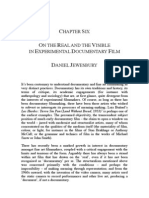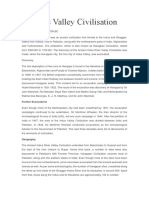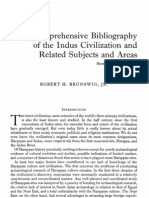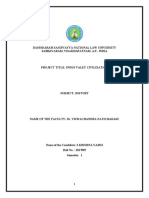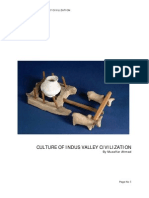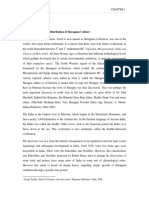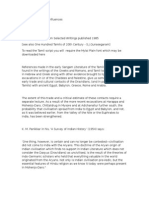Professional Documents
Culture Documents
History: (For Under Graduate Student)
History: (For Under Graduate Student)
Uploaded by
Mrunal Nolan0 ratings0% found this document useful (0 votes)
89 views10 pagesThe document provides background information on the Indus Civilization, including its extent, discovery, and debates around its origins. It can be summarized as:
1) The Indus Civilization emerged around 4th millennium BC in the Indus River valley and extended throughout modern-day Pakistan and western India, covering a large area.
2) It was first discovered in the early 1850s during railway construction works in Harappa and Mohenjo-Daro. Further excavations in the 1920s uncovered more sites.
3) There was debate among scholars about whether it originated locally or was a colony from Mesopotamia, but later excavations provided evidence of a pre-Harappan indigenous
Original Description:
civilsation
Original Title
indus
Copyright
© © All Rights Reserved
Available Formats
DOCX, PDF, TXT or read online from Scribd
Share this document
Did you find this document useful?
Is this content inappropriate?
Report this DocumentThe document provides background information on the Indus Civilization, including its extent, discovery, and debates around its origins. It can be summarized as:
1) The Indus Civilization emerged around 4th millennium BC in the Indus River valley and extended throughout modern-day Pakistan and western India, covering a large area.
2) It was first discovered in the early 1850s during railway construction works in Harappa and Mohenjo-Daro. Further excavations in the 1920s uncovered more sites.
3) There was debate among scholars about whether it originated locally or was a colony from Mesopotamia, but later excavations provided evidence of a pre-Harappan indigenous
Copyright:
© All Rights Reserved
Available Formats
Download as DOCX, PDF, TXT or read online from Scribd
Download as docx, pdf, or txt
0 ratings0% found this document useful (0 votes)
89 views10 pagesHistory: (For Under Graduate Student)
History: (For Under Graduate Student)
Uploaded by
Mrunal NolanThe document provides background information on the Indus Civilization, including its extent, discovery, and debates around its origins. It can be summarized as:
1) The Indus Civilization emerged around 4th millennium BC in the Indus River valley and extended throughout modern-day Pakistan and western India, covering a large area.
2) It was first discovered in the early 1850s during railway construction works in Harappa and Mohenjo-Daro. Further excavations in the 1920s uncovered more sites.
3) There was debate among scholars about whether it originated locally or was a colony from Mesopotamia, but later excavations provided evidence of a pre-Harappan indigenous
Copyright:
© All Rights Reserved
Available Formats
Download as DOCX, PDF, TXT or read online from Scribd
Download as docx, pdf, or txt
You are on page 1of 10
HISTORY
Subject : History
(For under graduate student)
Paper No. : Paper-I
History of India
Unit, Topic & Title : Unit- 4
Topic- 2
Indus Civilization
Lecture No. & Title : Lecture 1
Extent, Nomenclature and Origin
Indus Civilization: Extent, Nomenclature and Origin
The rising sun over the Indus seems to defy the soft mist
spread over it as a blanket, so that the sleeping splendor of
the past is not disturbed. Here lay the remains of a civilization
that thrived for about three millennia. This is the Indus
Civilization, knowledge of which began with the discovery of
two cities, Harappa and Mohenjo Daro. It had a deep impact
not only on history but on the entire Indian civilization.
The discovery of these two cities, namely Harappa and
Mohenjo Daro, linked by the river Indus actually pushed back
the origins of the Indian Civilization to the fourth millennium
BC. Commenting on this, historian Irfan Habib has said that
along with the civilizations of Egypt and Mesopotamia, the
Indus Civilization emerged as the third great civilization in the
whole world.
The Indus civilization marks the first phase of urbanization in
India as it was essentially confined to the cities. The first
civilization that the Indian sub-continent witnessed was thus
urban in nature. The earliest evidence of this civilization was
accidentally discovered by Alexander Cunningham, who was
neither an archaeologist nor a historian but a British engineer.
1853 was a momentous year in the history of our country
because railway lines were being laid for the first time. The
process involved a lot of digging, and it was while this work
was going on that Cunningham accidentally stumbled across
the first Harappan seal, inscribed with a bull and six letters of
a script that has still defied attempts at deciphering by
scholars. (He obviously did not know it was a Harappan seal
till it was identified as one later on).
But Cunningham undoubtedly deserves credit for discovering
the earliest specimen relating to the Indus Civilization.
Although the Archaeological Survey of India had been
established in 1896, it was not before 1921 that excavation
work at Harappa was carried out by Dayaram Sahni. Around
about the same time Mohenjo Daro was discovered by
Rakhaldas Banerjee. Since then (1921-22), for the rest of the
British colonial period (twenty-five years), many
archaeologists were engaged in excavation work in this area.
The earliest historians or archaeologists connected with the
study of the Indus Civilization were Dayaram Sahni,
Rakhaldas Banerjee, John Marshall, E. Mackay and Mortimer
Wheeler.
Excavations continued methodically and meticulously, in the
post colonial, post-partition period, (ie. after 1947), both by
archaeologists of the newly founded state of Pakistan and
India. The Kot Diji and Amri sites in the Dadu district of the
Lower Indus were discovered in 1958, followed by
excavations in Haryana, Rajasthan and Gujarat. Lothal,
believed to be a major sea port in Gujarat was discovered in
1964. A hundred and sixty kilometers to the south, Malawan
(close to Surat) was also identified as an Indus site. The next
discovery was the extremely important site of Dholavira,
located on Khadirabet, an island in the Great Rann of Kutch
(Gujarat) between 1989 and 1990. Excavations at Kalibangan
(North Rajasthan, 200 miles west of Delhi) Banawali and
Rakhigarhi, have revealed further sites that bear testimony to
the spread of the civilization towards the east. Alamgirpur in
the Meerut district in the central Ganges-Yamuna Doab is
considered as marking the farthest extension of the Indus
culture in the east. Towards the north, in Punjab, lay the site
of Rupar, (in the foothills of the Himalayas), marking possibly
the farthest outpost in northern India. Another similar site
was Manda in Jammu and Kashmir. The Indus Civilization
appears to be essentially a culture of the plains, as it does not
seem to have crossed the sub Himalayan foothills. In the
west, the civilization penetrated to Baluchistan upto Sutkagen
Dor, close to Pakistan's border with Iran.
The extent of the Indus Civilization on the whole, in terms of
modern territorial boundaries, may be assumed to have
covered almost the whole of Punjab (both in the Indian Union
as well as in Pakistan), Haryana, parts of Western UP,
northern Rajasthan, Sindh, most of Gujarat and parts of
North-eastern and southern Baluchistan. This gives one an
idea of the large area covered by the Indus civilization.
There exists some confusion regarding whether it would be
preferable to term this civilization as the ‘Harappan
civilization’, or as the ‘Indus Valley Civilization’. As Harappa
happened to be the first site to be excavated by Dayaram
Sahni, the entire culture came to be called the Harappan
culture. There is an unwritten understanding among scholars
that a civilization is designated by the earliest site to be
discovered. It was Mortimer Wheeler who in his report on the
excavations at Harappa way back in 1946, and again in 1953
in his book titled ‘The Indus Civilization used the term ‘Indus
civilization’ to denote this particular civilization. Even we, as
children had studied this civilization as the ‘Indus Valley
Civilization’. The explanation for the change in nomenclature
lies in the fact that over a period of time numerous
excavations have revealed to us, that the civilization was
spread out even beyond the Indus valley, thereby making it
inappropriate to refer to it as the Indus Valley Civilization any
longer. The eminent historian, Prof. D.K. Chakraborty
constantly reminds us why it is wrong to use the term "Indus
Valley Civilization", and emphasizes that it would be far more
accurate to call it the Indus Civilization or even as Harappan
Civilization. He himself prefers using the term Harappan
Civilization as he feels that it being a geographically non-
committal term is the most suitable. He also says that it is
only out of deference to its long usage, that the term Indus
Civilization may be used.
A question arises in this connection as to why this civilization
was not named after Mohenjodaro. The simple answer to this
is that Harappa was the first site to be discovered and in
terms of chronology Mohenjodaro came a little later. Anyway,
according to the practice of naming a civilization by the name
of the first site where it has been discovered, this civilization
should be referred to as the Harappan Civilization and not by
any other name.
There is a difference of opinion among scholars regarding the
genesis of this civilization. While some claim that it originated
indigenously, others say that it was a colony of some other
civilization. Historians like John Marshall, V.Gordon Childe,
Stuart Piggot, and Nani Gopal Majumdar, belonged to a
school who empasized categorically the indigenous origin of
the civilization. V.Gordon Childe further explained that it
formed the basis of modern Indian culture, which then leads
to the question of whether the civilization is still evident at
present, and if so what the features were those links the
present with the Harappa Civilization. Nani Gopal Majumdar
who carried out extensive work in the region of Amri in Sindh
between 1929 and 1931 came to the conclusion that the
pottery he discovered in Amri had a very distinct style of its
own, and should be looked upon as the earlier stage of the
Chalcolithic Civilization that is represented by Harappa and
Mohenjo Daro.
On the other hand we have Sir Mortimer Wheeler who
believed that the civilization of the Indus Plain actually came
from Mesopotamia, and that the Indus civilization was nothing
but an extension of the Mesopotamian Civilization. There were
others like Heine-Geldern (writing in 1956), and Gordon
(writing in 1958),who agreed with him, and considered the
cities of Harappa and Mohenjodaro to be colonial cities. They
claimed to have detected some amount of foreign influence in
the architectural designs of these two towns, strengthening
their theory that these citadels were actually colonial towns,
and that they were definitely an extension of the
Mesopotamian civilization.
However as more excavations were carried out in the 1950’s
and 1960’s further data poured in that changed the entire
perspective of the Indus Civilization. These excavations
pushed the period of the civilization far back into history.
Between 1955 and 1957, extensive excavation work at Kot
Diji, revealed a fortified citadel castle below the Harappan
level of the site. J.M. Casal who wrote between 1959 and
1962 lent support to Nani Gopal Majumdar's find of a pre-
Indus level, which he identified as a transitional stage
between the early Amri culture and later Indus civilization.
Nani Gopal Majumdar termed it as pre-Indus, and pointed out
that Amri pottery had a very distinct culture of its own.
The third major excavation was carried out in Kalibangan by
B.B. Lal and B.K. Thapar. The excavations here threw up
similar results, -a fortified and pre-Indus settlement- towards
the western sector of this site. Basically these three major
excavations served to indicate that the Indus culture was of
indigenous origin. The debate was thus finally resolved in
favour of those who put forth the theory of indigenous origin.
Along with this began the use of new terminology regarding
the periodisation of the Indus civilization. Whereas earlier
historians would speak of just three periods, - the Early, the
Mature and the Late Harappan period, now they began
speaking about a pre- Harappan period, necessitated by the
findings at Kot Diji, Kalibangan and other sites. Scholars were
becoming aware that the whole process of the germination,
maturity and end of the Harappa civilization spanned a long
period of 2200 years between 3500 B.C. and 1300 B.C. Three
stages of evolution may be identified as, -- the pre-Harappan
or the Early Harappan, followed by the Mature Harappan
stage and finally the Late Harappan stage.
Archaeologists also made the significant discovery that the
ground for the Indus Civilization was prepared by the early
Neolithic and Chalcolithic culture of the 8th and 7th
millennium B.C. which denotes that it had not just cropped
up all of a sudden. Just as ‘Rome was not built in a day’, so
also the Indus civilization was not built in a day. The gradual
evolution of this civilization began with the Chalcolithic culture
which preceded it and was regarded by scholars as the Early
Harappan culture. Then followed the Mature Harappan stage
when urbanization had reached a fully developed form, and
then the Late Harappan Stage denoting the stage of decline.
The Harappan Civilization was the most ancient civilization in
South-east Asia. This extinct civilization according to some
historians is perhaps the third major civilization after Egypt
and Mesopotamia. In the beginning it was thought that this
civilization existed only in the Indus river valley but over a
period of time further archaeological discoveries pushed its
boundaries to Surat in the south, Meerut in the east, Kashmir
in the north and the border of Pakistan and Iran in the west.
Therefore, it is now called the Indus Civilization rather than
Indus Valley Civilization. There were controversies about its
origin earlier but later, extensive archaeological excavations
proved beyond doubt that these civilizations were indigenous
in nature and not colonies of other civilizations.
You might also like
- Journey of CivilizationDocument4 pagesJourney of Civilizationhusankar2103100% (3)
- Brahman The Discovery of The God of AbrahamDocument127 pagesBrahman The Discovery of The God of AbrahamEnrico Baccarini100% (1)
- On The Real and The Visible in Experimental Documentary FilmDocument12 pagesOn The Real and The Visible in Experimental Documentary FilmDaniel JewesburyNoch keine Bewertungen
- R. D. Banerji - Prehistoric Ancient Hindu IndiaDocument369 pagesR. D. Banerji - Prehistoric Ancient Hindu IndiaAmit Pathak100% (3)
- Origins of HarappaDocument4 pagesOrigins of HarappaSandhya BossNoch keine Bewertungen
- Name Origin of The Indus CivilizationDocument10 pagesName Origin of The Indus CivilizationYaar Jigree Season 3Noch keine Bewertungen
- The Ancient Indus CivilizationDocument11 pagesThe Ancient Indus CivilizationTurfa AhmedNoch keine Bewertungen
- Indus Valley CivilisationDocument4 pagesIndus Valley CivilisationRohan PandhareNoch keine Bewertungen
- Histroy of Indus Valley Civilizaton 55Document25 pagesHistroy of Indus Valley Civilizaton 55Wasil AliNoch keine Bewertungen
- A Brief History of Indus ValleyDocument7 pagesA Brief History of Indus ValleyAqeel JanjuaNoch keine Bewertungen
- A Comprehensive Bibliography of The Indus CivilisationDocument37 pagesA Comprehensive Bibliography of The Indus CivilisationMartin ČechuraNoch keine Bewertungen
- Some Several Thousand Years Ago There Once Thrived A Civilization in The Indus ValleyDocument12 pagesSome Several Thousand Years Ago There Once Thrived A Civilization in The Indus ValleynidhikasterNoch keine Bewertungen
- Harappan CivilizationDocument7 pagesHarappan Civilizationlovleshruby100% (1)
- The Harappan CivilizationDocument16 pagesThe Harappan CivilizationnitrovertNoch keine Bewertungen
- The Harappan CivilizationDocument6 pagesThe Harappan Civilizationzxcv2010100% (1)
- Ancient India - World History EncyclopediaDocument10 pagesAncient India - World History EncyclopediaNamsangLimbooNoch keine Bewertungen
- The Enigmatic City of Atlantis and Vedic CivilizationDocument18 pagesThe Enigmatic City of Atlantis and Vedic CivilizationAmlan Roychowdhury100% (3)
- History of IndiaDocument10 pagesHistory of IndiaKenzy talkstoomuchNoch keine Bewertungen
- Is The Ashokan Brahmi Script Derived FroDocument7 pagesIs The Ashokan Brahmi Script Derived FroSubramanian Kannan100% (1)
- Faults and Errors of Romila ThaparDocument11 pagesFaults and Errors of Romila ThaparArpan DeyNoch keine Bewertungen
- Development Team: Paper No.: 03 Archaeological Anthropology Module: 13 Indus Valley CivilizationDocument21 pagesDevelopment Team: Paper No.: 03 Archaeological Anthropology Module: 13 Indus Valley CivilizationKoushik GhoshNoch keine Bewertungen
- The Indus Valley CivilizationDocument33 pagesThe Indus Valley CivilizationAbhishek Gandhi100% (7)
- Indus Valley CvilizationDocument24 pagesIndus Valley Cvilizationvamsi100% (1)
- History NotesDocument47 pagesHistory NotesYadvendra Singh RanaNoch keine Bewertungen
- HarappaDocument28 pagesHarappaShubham Trivedi92% (13)
- Indus Valley CivilisationDocument3 pagesIndus Valley CivilisationAmarinder BalNoch keine Bewertungen
- A Short History of AfghanistanDocument217 pagesA Short History of AfghanistanKrishna ChauhanNoch keine Bewertungen
- Ancient India: A Captivating Guide to Ancient Indian History, Starting from the Beginning of the Indus Valley Civilization Through the Invasion of Alexander the Great to the Mauryan EmpireFrom EverandAncient India: A Captivating Guide to Ancient Indian History, Starting from the Beginning of the Indus Valley Civilization Through the Invasion of Alexander the Great to the Mauryan EmpireNoch keine Bewertungen
- (Sir William Meyer Lectures) K. N. Dikshit - Prehistoric Civilization of The Indus Valley-Indus Publications (1988)Document87 pages(Sir William Meyer Lectures) K. N. Dikshit - Prehistoric Civilization of The Indus Valley-Indus Publications (1988)Avni ChauhanNoch keine Bewertungen
- Culture of Indus ValleyDocument20 pagesCulture of Indus Valleykunalkataria100% (1)
- Prehistoric India - Indus Valley CivilizationDocument19 pagesPrehistoric India - Indus Valley CivilizationShivam100% (2)
- Indus Valley Civilization-2257Document5 pagesIndus Valley Civilization-2257RATHLOGICNoch keine Bewertungen
- Chapter-I India Through The AgesDocument62 pagesChapter-I India Through The AgesashishNoch keine Bewertungen
- General Studies (For Civil Services Preliminary Examination)Document27 pagesGeneral Studies (For Civil Services Preliminary Examination)Dharm SainiNoch keine Bewertungen
- Indian Church HistoryDocument59 pagesIndian Church HistoryKyaw thant zinNoch keine Bewertungen
- Chinese (Yellow River) - All These Bronze Age Civilizations Had Different Technological LevelsDocument17 pagesChinese (Yellow River) - All These Bronze Age Civilizations Had Different Technological LevelsbastobdasNoch keine Bewertungen
- General Studies - I: Section - I: History and Cultural Heritage (India and Karnataka)Document9 pagesGeneral Studies - I: Section - I: History and Cultural Heritage (India and Karnataka)Manju KiranNoch keine Bewertungen
- Gujarat Administrative Services Prelims Full SyllabusDocument9 pagesGujarat Administrative Services Prelims Full SyllabusAbhishek KumarNoch keine Bewertungen
- Ancient India for Kids - Early Civilization and History | Ancient History for Kids | 6th Grade Social StudiesFrom EverandAncient India for Kids - Early Civilization and History | Ancient History for Kids | 6th Grade Social StudiesNoch keine Bewertungen
- The Myth of Aryan Invasion TheoryDocument26 pagesThe Myth of Aryan Invasion TheoryAnupam Manur100% (3)
- BsjsjsDocument27 pagesBsjsjsनटराज नचिकेताNoch keine Bewertungen
- Historical Review of Mohenjo-Daro and Harappan CivDocument12 pagesHistorical Review of Mohenjo-Daro and Harappan CivAimen ParachaNoch keine Bewertungen
- Indus Valley Civilization: Presented byDocument21 pagesIndus Valley Civilization: Presented byAravind EcrNoch keine Bewertungen
- India: 2. Research On The Civilizations Of: 2.1 IndiaDocument21 pagesIndia: 2. Research On The Civilizations Of: 2.1 IndiaJamNoch keine Bewertungen
- The Story of India: ExcerptsDocument13 pagesThe Story of India: Excerptsjeevesh1980Noch keine Bewertungen
- GVC To IVC To SVC (Ganges Valley Civilization To Indus Valley Civilization To Sarasvati Valley Civilization) PDFDocument28 pagesGVC To IVC To SVC (Ganges Valley Civilization To Indus Valley Civilization To Sarasvati Valley Civilization) PDFanjanaNoch keine Bewertungen
- IVCDocument4 pagesIVCrupalm02Noch keine Bewertungen
- Sri Michel Danino: A Noted HistorianDocument3 pagesSri Michel Danino: A Noted HistorianParthasarathi DattaNoch keine Bewertungen
- Harappan CivilizationDocument66 pagesHarappan CivilizationJnanam33% (3)
- Early Tamil Cultural InfluencesDocument24 pagesEarly Tamil Cultural Influencesmadhanraj91100% (1)
- Hand Gestures From RvpuramDocument46 pagesHand Gestures From RvpuramadeeshmidasNoch keine Bewertungen
- Indus Valley CivilizationDocument4 pagesIndus Valley CivilizationShreyaa Lakshmi Prasanta BanerjeeNoch keine Bewertungen
- IndusDocument15 pagesIndusnaveenarora298040Noch keine Bewertungen
- Indus Valley CivilizationDocument51 pagesIndus Valley CivilizationsyedmirsyedNoch keine Bewertungen
- RS SharmaDocument2 pagesRS SharmaRonnie ChatterjeeNoch keine Bewertungen
- Ancient History 04 - Daily Class Notes - UPSC Sankalp 3.0 (Hinglish)Document4 pagesAncient History 04 - Daily Class Notes - UPSC Sankalp 3.0 (Hinglish)jakatiupdateclassesNoch keine Bewertungen
- Indus Valley CivilizationDocument69 pagesIndus Valley Civilizationfeeamali1445Noch keine Bewertungen
- History of India: A brief introduction about Indian History ( all periods)From EverandHistory of India: A brief introduction about Indian History ( all periods)Noch keine Bewertungen
- Creativity and InnovationDocument37 pagesCreativity and InnovationNurshafiqa KhalitNoch keine Bewertungen
- Making A Start SDocument5 pagesMaking A Start SMaria TowersNoch keine Bewertungen
- By Emma GroeneveldDocument8 pagesBy Emma GroeneveldbababNoch keine Bewertungen
- Contact Details of Officials of Common Service CentresDocument2 pagesContact Details of Officials of Common Service CentresRaghu Veer100% (2)
- Social Construction of BeautyDocument15 pagesSocial Construction of BeautyputriikbalNoch keine Bewertungen
- Apgvb Oa Results 2010Document21 pagesApgvb Oa Results 2010Sasi KrishnaNoch keine Bewertungen
- Of White Hairs and Cricket LitChartDocument28 pagesOf White Hairs and Cricket LitChartrehmarathore5Noch keine Bewertungen
- A Lesson Plan in English Grade 8Document3 pagesA Lesson Plan in English Grade 8Mohamed BalbaaNoch keine Bewertungen
- Toki Pona Lessons - en BookletDocument5 pagesToki Pona Lessons - en BookletThienNoch keine Bewertungen
- Admin Block ElevationDocument1 pageAdmin Block ElevationOladunni AfolabiNoch keine Bewertungen
- Textos Ingles ImprimirDocument7 pagesTextos Ingles ImprimirSirJoseNoch keine Bewertungen
- Principles and Strategies of Teaching Learning MakabayanDocument6 pagesPrinciples and Strategies of Teaching Learning MakabayanKevin Fernandez MendioroNoch keine Bewertungen
- Gwen Anne B. Agorilla, STEM XII - Euler August 29, 2019: WikaDocument1 pageGwen Anne B. Agorilla, STEM XII - Euler August 29, 2019: WikaGwen AgorillaNoch keine Bewertungen
- Solomon Cb12 CultureDocument56 pagesSolomon Cb12 CultureWerchampiomsNoch keine Bewertungen
- VARC QUESTIONS (3) (AutoRecovered)Document56 pagesVARC QUESTIONS (3) (AutoRecovered)GomishChawlaNoch keine Bewertungen
- COUNSELLORS-Southern Region: Sl. No Name Gender City Mobile/ Whatsapp No Email Assistance Timings LanguagesDocument3 pagesCOUNSELLORS-Southern Region: Sl. No Name Gender City Mobile/ Whatsapp No Email Assistance Timings LanguagesAbhilash MohapatraNoch keine Bewertungen
- GlobalizationDocument3 pagesGlobalizationAnnie Jane SamarNoch keine Bewertungen
- Padaung Tribe of MyanmarDocument8 pagesPadaung Tribe of Myanmarnso2m2Noch keine Bewertungen
- (Book) Kathryn Hinds - Scythians and Sarmatians BarbariansDocument81 pages(Book) Kathryn Hinds - Scythians and Sarmatians Barbarianswaouu100% (3)
- Technics and The Nature of ManDocument16 pagesTechnics and The Nature of ManDaniel VargasNoch keine Bewertungen
- Human Dignity in IslamDocument11 pagesHuman Dignity in IslamRidha Abdul Rahman0% (1)
- Immigration and Identity Crisis in Bharathi Mukerjee'S Wife and Tiger'S Daughter: An AssessmentDocument12 pagesImmigration and Identity Crisis in Bharathi Mukerjee'S Wife and Tiger'S Daughter: An Assessmentganapathy2010svNoch keine Bewertungen
- China Studies in India - Amandeep Singh HanspalDocument4 pagesChina Studies in India - Amandeep Singh HanspalsinamandeepNoch keine Bewertungen
- Bootstrap ExampleDocument1 pageBootstrap ExamplevaishnaviNoch keine Bewertungen
- Alvarado Assignment 3.1 Literary-Theories and Shrek 2Document2 pagesAlvarado Assignment 3.1 Literary-Theories and Shrek 2Ben Aldrian Tariao Ibañez100% (3)
- TED Talk - The Danger of A Single StoryDocument6 pagesTED Talk - The Danger of A Single Storykeyag100% (1)
- The Traditional Chinese Way of LifeDocument4 pagesThe Traditional Chinese Way of LifeamirNoch keine Bewertungen
- Fly Me To The Moon 2022 Cruz Salsa PIANODocument6 pagesFly Me To The Moon 2022 Cruz Salsa PIANOPablo ROmaNoch keine Bewertungen
- Tapestry PDFDocument6 pagesTapestry PDFbongumanNoch keine Bewertungen


